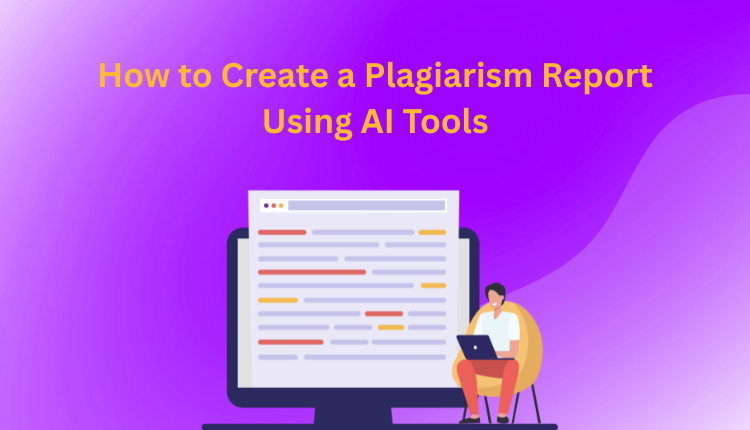Plagiarism is a growing concern in academia, professional writing, and content creation. Defined as the appropriation of another person’s ideas, text, or work as one’s own, plagiarism poses ethical issues and challenges originality and integrity. Combatting this issue often requires a plagiarism report—a comprehensive document that analyzes written content, flags copied segments, identifies matched sources, and promotes ethical writing practices.
Whether you’re an academic writer, a content editor, or a corporate professional, generating a plagiarism report ensures originality and credibility in your work. This guide will walk you through the importance, steps, and tools for creating an effective plagiarism report, highlighting features of AI-driven platforms like Trinka to optimize accuracy and efficiency.
The Importance of Plagiarism Reports
Understanding why plagiarism reports are critical helps establish their role in professional and academic writing:
- Upholding Academic Integrity: Academic institutions and publishers require authors to adhere to plagiarism-free writing standards, ensuring the originality of research articles, theses, and assignments.
- Boosting Credibility: Plagiarism affects not just the content in question but also the writer’s reputation. A detailed report validates your commitment to authenticity.
- Respecting Intellectual Property: Proper attribution to authors and creators protects intellectual property and highlights your ethical writing practices.
- Aligning with Publisher Requirements: Publishers frequently demand plagiarism reports during the submission process. By providing a report, you improve your chances of manuscript acceptance.
Key Components of a Plagiarism Report
A complete plagiarism report includes the following details:
- Plagiarism Percentage: Representation of the percentage of text flagged as similar to other sources.
- Identified Sources: A list of original sources matching the content, along with their URLs and publication details.
- Flagged Text: Sections of text highlighted to indicate potential plagiarism.
- Citation Details: Proper citations and credits for matched portions.
- Recommendations for Revisions: Suggestions on rephrasing or rewriting flagged segments.
Steps to Generate a Plagiarism Report
Follow these straightforward steps to create an accurate and effective plagiarism report:
1. Choose a Reliable Plagiarism Detection Tool
Select a powerful plagiarism checker tailored to your specific needs. For instance:
- Trinka AI: Ideal for academic writers, offering not just plagiarism detection but also style, grammar, and tone enhancements.
2. Upload the Document
Upload your content to the platform in compatible formats such as DOCX or PDF.
3. Run the Plagiarism Scan
Initiate the scan to compare your document against vast databases covering journals, books, websites, and online repositories.
4. Analyze the Results
- Review flagged areas, often highlighted in color.
- Examine matching percentages and their corresponding sources.
- Check details like hyperlinks, side-by-side comparisons, and content summaries.
5. Customize the Report
Most tools allow customization of the report. Ensure it includes:
- Summarized statistics.
- Exemptions for commonly cited phrases or bibliographies.
- Comprehensive source information for flagged sections.
6. Save and Share
Export the report into formats like PDF for documentation or sharing with professors, reviewers, or editors.
7. Revise the Content
Rephrase flagged sections using the tool’s suggestions or advanced paraphrasing features, such as Trinka AI’s context-aware paraphrasing.
Best Practices for an Effective Plagiarism Report
- Exclude Bibliographies: Reference sections may falsely trigger plagiarism alerts; omit them to prevent inaccuracies.
- Document All Sources: Even fractional similarities matter in professional settings. Aim for transparency.
- Ensure Depth of Rephrasing: Avoid superficial word changes—rewrite passages to reflect original thought and understanding.
- Opt for Field-Specific Tools: Writers in academia will benefit from tools like Trinka, which cater to specific styles and terminology.
- Check Copyright Policies: Reconfirm permissions while quoting or paraphrasing copyrighted material.
Avoiding Common Mistakes in Plagiarism Detection
While plagiarism detection tools are highly advanced, avoiding these errors is critical:
- Overconfidence in Automation: Tools may miss poorly paraphrased content or instances of self-plagiarism. A manual review helps overcome such gaps.
- Overlooking Minor Matches: Even small overlaps can lead to accusations in academic and professional settings. Address every flagged section.
- Skipping Revisions: Submitting plagiarized content—even with a report—may attract criticism. Always revise based on suggestions.
Why Trinka Stands Out for Plagiarism Detection
Trinka AI offers advanced AI features for plagiarism detection in academic and professional contexts:
- Academic-Focused Database: Trinka’s database excels at scanning academic texts, including journal databases and technical articles.
- Comprehensive Paraphrasing Suggestions: Enhanced paraphrasing helps users craft authentic, clear revisions without altering the intent.
- Detailed Report Generation: Generate personalized and shareable reports that highlight flagged areas, source links, and revisions.
- Integrated Writing Assistance: Trinka combines grammar checks, tone optimization, and consistency improvements with plagiarism detection, ensuring your content is polished comprehensively.
Conclusion
Creating a plagiarism report is indispensable for producing ethical, high-quality, and credible content. By following structured steps and leveraging specialized tools like Trinka, you can efficiently analyze, revise, and authenticate your work for the highest standards of integrity. Whether academic, professional, or creative, a plagiarism-free document speaks volumes about your dedication to originality. Elevate your writing and streamline plagiarism checks with Trinka’s AI-powered tools today.

